Dubrovnik
‘Three countries in four days’
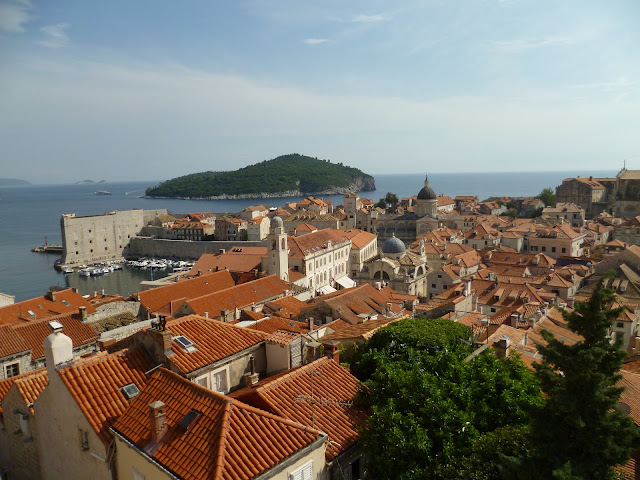 |
| Dubrovnik with Lokrun in the background |
Well here we are again in Croatia, I’m like a man on an
elastic band, four trips in the last two years. This time I’m doing the southern
bit, that little strip of land that snakes south east down the Dalmatian coast
and peters out into Montenegro, containing the jewel of Dubrovnik.
Dubrovnik is a must see, a wonderfully preserved medieval
walled city that must be contender for most beautiful town in the Mediterranean,
sitting as it does with its massive ramparts and terracotta roofs on the
sparkling Adriatic. It is an ideal destination for a weekend city break. If scousers
can nip down to Barcelona from John Lennon Airport for an evening meal and come
back the same night, then a Friday to Sunday in Dubrovnik is a ‘can do.’ Monarch
airline is worth considering. They were doing about the cheapest tickets for
when I wanted to fly out on a Tuesday and back on a Saturday for about £221.
Dubrovnik has an illustrious history as a great trading
republic, once called Ragusa and a prestigious rival to the Venetian republic.
Surviving on trade, it also has a history of liberal politics and a passion for
freedom. It even escaped the yoke of the Ottoman Empire with whom it was able
to do a deal by paying tribute to the Turks. In 1667 there was a bad earthquake
that razed most of the buildings to the ground, so much of what you see is the
medieval new build. The only time it ever fell was when Napoleon’s army was
invited in, as long as it respected the city’s independence. In more recent
history it was bombed by the Yugoslav army quite badly for no apparent
strategic reason, guaranteed not to make them popular with the rest of the
world! At various points around the city are displays showing how much damage
afflicted Dubrovnik, with a map of where the shells fell.
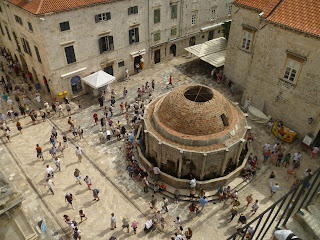 |
| Water fountain at Pile Gate |
Stride the bridge over the moat and through Pile Gate, and
you are nearly at the beginning of Stradun, the spiritual centre of the city. Just
inside the gate is also a hub for the city, with the ancient Onofrio Fountain,
a circular affair which was part of the original water supply system. It still
pumps water through sixteen taps into a channel running round the outside of
the structure where you can fill your bottle. On the left is the Franciscan
Monastery of the Friars Minor and the Old Pharmacy. Here you can wander the
cloisters with its colourful old frescoes, then dip into the museum bit with
its artefacts and manuscripts. Perhaps the most interesting part is a mock up
of the old pharmacy where I was told off for taking photos! There is actually a
working pharmacy at the point where you enter the complex, in fact the oldest
working pharmacy in Europe. Also on the left of the street here is the Church
of St Saviour, built about 1520 as a symbol of thanks by survivors after a
bad earthquake. It is now used for concerts and suchlike.
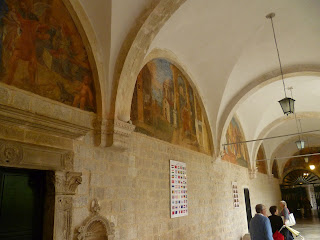 |
| Franciscan monastery frescoes |
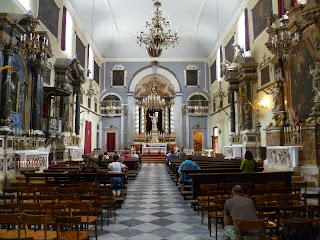 |
| Dubrovnik church |
The Stradun, the main walking thoroughfare, scythes through
the centre of the city in a dead straight line from Pile Gate in the west to Ploce
Gate and the harbour in the east. Above the main gates are reliefs of St
Blaise, protector of the city. At night Stradun is like Darth Vader’s
lightsaber, straight as a rod, dazzling amongst the surrounding settlement,
jammed with promenaders and fed by ravine like alleyways that cascade down
steep stone stairways from the north and trickle in from the south on the flat.
Head down the Stradun and turn right at the bottom to face another mix of
classy buildings. On the left a little further up is the impressive Rector’s
Palace which also has the Cultural Historical Museum. On the right and marking
the end of Stradun is St Blaise Church which is named after the saint protector
of Dubrovnik. The present church was built in 1717 in Baroque style, and a
statue of the saint stands above the church entrance holding a scale model of
the old town.
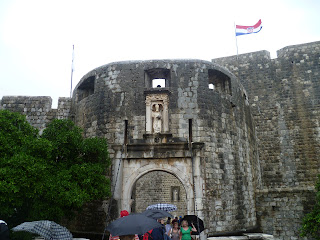 |
| There he is! St Blaise above Pile Gate |
Here at the end of Stradun the street also opens out into a
square which centres on Orlando’s column in front of the church of St Blaise. There
is a carving of Orlando, nephew of Charlemagne. An interesting aside is that
Orlando’s right forearm was the standard for the unit of measurement for
trading fabric – the Ragusan cubit. Over to the side is Onofrio’s small
fountain, as opposed to Onofrio’s big fountain at the other end of Stradun! This
area was once the marketplace and is still the political centre of Dubrovnik.
If you have turned right at the end of Stradun and are
heading south you hit a set of stairs up to a plaza on which stands the cathedral,
built between 1672 and 1713 by Italian architects. I popped in at night when
there were very few people in there. The treasures within include reliquairies
of St Blaise, with golden caskets supposedly containing the saints head and
foot. From the plaza are great views down the series of stone stairways into
the bowels of the city, especially evocative in the evening when the streets
teem with tourists, and restaurant tables everywhere spill into the streets.
You have to do the city walls walk, all the way round for 70kn,
a two kilometre stretch up and down with a treasure chest of great
perspectives, whether it’s across the city skyline, picking out the monastery,
cathedral and great churches, or another view of the massive walls falling into
the rocky shores of the Adriatic and out to the island of Lokrum. For another
50 kn you can get an audio guide to accompany you around.
The walls are seriously huge all the way round, jumbo
ramparts that must have provided a formidable barrier to anyone who dared to
invade, particularly the Ottoman Empire which lay just a few kilometres inland.
They were built between the eighth and sixteenth centuries. The perfectly
preserved walls encircle the city in an impregnable envelope and provide some
great camera scopes. One of the highlights is Minceta Fort north of Pile Gate,
one of the highest points on the wall with its stylised battlements. It’s a
favourite and crowded spot for photographers. Meanwhile at the eastern end of the walls you can nip
into the Maritime Museum on the way round. In the summer heat it’s quite a
stroll! So take plenty of water, although there is at least one water seller
and later a cafe on the way round.
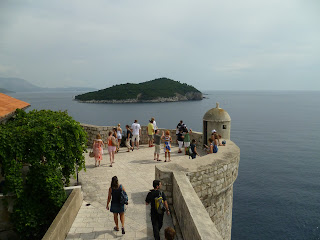 |
| Lokrum from the city walls |
Lovrijenac Fort is part of the city defences but is adrift
of the main walls to the west and sits on a headland. It’s well worth a visit
and don’t forget is included in the walls ticket, although be ready for a steep
(short!) climb up to the main gate. It was once used as a prison but now is
surrounded by parkland.
The Dominican monastery stands at the north east corner of
the city but is also a worthy visit. A 20 kuna entrance fee gives you access to
a calm gothic and renaissance cloister with a luxuriant carpet of grass in the
middle. Side doors take you through to exhibitions of icons, old Masters, and
various cases of jewellery and religious artefacts such as reliquaries,
chalices and flagons. Through another door is the large church auditorium,
quite an uplifting building as it is decorated in white and lacks the overdone,
dark and rather depressing trappings of many European Catholic churches. An
atmosphere of light is enhanced by brightly colourful and modern paintings on a
religious theme. But what capped the visit were a group of white robed monks
and assorted lay people practising the singing of ‘Amazing Grace,’ repeating
the verses with brief interludes for some tweaking. It was life enhancing to
hear a Roman Catholic Order singing such a massive theme tune of Protestant
Christianity. If you visit one church in Dubrovnik this is the one I would go
to.
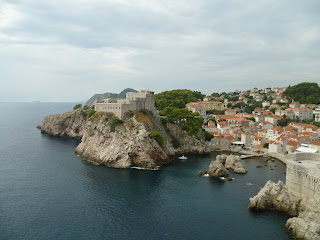 |
| Lovrijenac Fort |
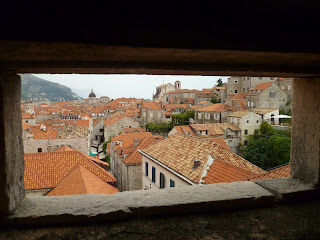 |
| View on the walls walk |
Dubrovnik has various beaches in the vicinity. You can go to
Lapad just to the west of the old town, whilst to the east is Banja Beach. The
latter is commercialised with music playing, deckchairs and umbrellas, a bar
and sports areas for volleyball, etc. So if you’re a babe or a hunk this is
perhaps where you would go! Another alternative is to walk down to the water
from Pile just outside the city walls where there are very small stretches of beach
and sunbathing areas around Lovrijenac Fort, or go a little further around the
headland to find a lovely stretch of rocky coast with sunbathing platforms and
a little cafe. This is where I ended up, an unhindered spot for late afternoon
sun and where you are likely to find the locals. Unfortunately I had to leave promptly
at 4pm to catch the bus to the airport.
The harbour on the east end of the city is like the mouth of a giant sea monster where people pour out of the city onto the quay. Here you can trace the outside of the walls for some distance around to the south, and dodge the stray cats that pop up everywhere. From here also you can catch the boat to Lokrum, a heavily wooded island and Nature Reserve a mere fifteen minutes away which transfers you out of the incessant hubbub into peace and quiet. Here you can climb the hill to the highest point on the island where an old French fort (1806) gives you great 360 degrees views across to the city and down the coast. Peacocks wander all over the place, there is a monastery (founded in 11th century), botanical gardens, a pool, and cafe/restaurant. When you get off at the jetty, if you fancy bathing in the buff there is an FKK beach specially set aside for nudists and discreetly placed away from prying eyes. I had no wish to pursue this and instead crossed the narrow island to find a sunbathing spot on a rocky shoreline fully exposed to the afternoon sun in the west. The gentle sea could be entered by a strategically placed set of metal steps. There are numerous beaches around the island and Lokrum is one of the best spots for a swim.
You can get a Dubrovnik Card valid for 1, 3 or 7 days (130, 180, 220kn) which allow entrance to museums, galleries and the City Walls, up to 20 rides on public transport, with a free guide and various discounts (children under 12 free if parents have Card). There are numerous museums and churches which I did not have time to see, but I did see from the outside the old synagogue (1352), the second oldest in Europe after Prague, on Zudioska, one of the steep alleyways tumbling down to the Stradun. It has a museum and was once part of the Jewish ghetto. The Jews settled here at the end of the fifteenth century after leaving Spain and Portugal, and enjoyed relative wealth and freedom despite some restrictions. Meanwhile on Od Puca south of the Stradun is the Serbian Othodox Church (quite big and built 1865-1877) and Museum of Icons which I just observed from the outside. I was not really in the mood to look at lots of old icons.
I stayed in Bosnia-Herzegovina, just over the border from
Croatia and about 8km from Dubrovnik. High in the coastal hills overlooking the
Adriatic is the village of Ivanice where Katrina rents out an apartment on
Airbnb. The apartment is part of a building inhabited by the family, mother,
father and grandmother. Up some stairs and on the first floor, the rental
apartment is virtually self contained and ideal for a couple or family. There are
great views out over the village and to the Adriatic. To get to Dubrovnik you
have to cross the border, which means negotiating both the Bosnian and Croatian
border posts, so you must carry your passport at all times. With Kristina
driving and being a local it was a pretty easy crossing. I read somewhere that
even within Croatia you are supposed to carry your passport but I have never
been asked to produce it within the borders.
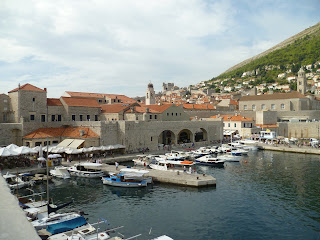 |
| Dubrovnik Harbour |
The harbour on the east end of the city is like the mouth of a giant sea monster where people pour out of the city onto the quay. Here you can trace the outside of the walls for some distance around to the south, and dodge the stray cats that pop up everywhere. From here also you can catch the boat to Lokrum, a heavily wooded island and Nature Reserve a mere fifteen minutes away which transfers you out of the incessant hubbub into peace and quiet. Here you can climb the hill to the highest point on the island where an old French fort (1806) gives you great 360 degrees views across to the city and down the coast. Peacocks wander all over the place, there is a monastery (founded in 11th century), botanical gardens, a pool, and cafe/restaurant. When you get off at the jetty, if you fancy bathing in the buff there is an FKK beach specially set aside for nudists and discreetly placed away from prying eyes. I had no wish to pursue this and instead crossed the narrow island to find a sunbathing spot on a rocky shoreline fully exposed to the afternoon sun in the west. The gentle sea could be entered by a strategically placed set of metal steps. There are numerous beaches around the island and Lokrum is one of the best spots for a swim.
 |
| Harbour with Lokrum island in the background |
You can get a Dubrovnik Card valid for 1, 3 or 7 days (130, 180, 220kn) which allow entrance to museums, galleries and the City Walls, up to 20 rides on public transport, with a free guide and various discounts (children under 12 free if parents have Card). There are numerous museums and churches which I did not have time to see, but I did see from the outside the old synagogue (1352), the second oldest in Europe after Prague, on Zudioska, one of the steep alleyways tumbling down to the Stradun. It has a museum and was once part of the Jewish ghetto. The Jews settled here at the end of the fifteenth century after leaving Spain and Portugal, and enjoyed relative wealth and freedom despite some restrictions. Meanwhile on Od Puca south of the Stradun is the Serbian Othodox Church (quite big and built 1865-1877) and Museum of Icons which I just observed from the outside. I was not really in the mood to look at lots of old icons.
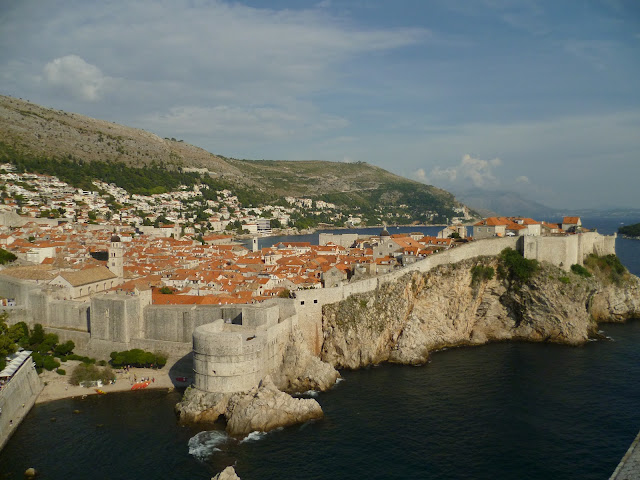 |
| Great view of Dubrovnik |
My whole experience with airbnb was positive. I stumbled
upon the company looking for a room in the Dubrovnik area on the internet. Airbnb
is a worldwide venture which provides private households with an opportunity to
rent out their property to tourists and make a little extra cash. It is
designed to be a safe value for money alternative to staying in a hotel. The
web experience is well designed to allow a client to search for a room, review
various alternatives which advertise full details together with photographs,
and then communicate their preferences. The company provides software to
swiftly communicate with possible renters in security and safety. Once a final decision
has been made payment can be arranged by credit card. I was impressed with the
watertight process and quick communication with my choice. Being the first time
I had used this service one was a little apprehensive, but I was much reassured
by an article in the Monarch Airline in-flight magazine on this very company.
Bus ticket Dubrovnik to Gornji Brgat: 15kn
Lasagne, salad and fanta: 141 kn
A spinach pie and a lemon fanta: 28kn
Supermarket apple, banana, small water, small bread, portion of cheese and tomato: 30.79kn
Supermarket water: 10kn
Large icecream: 16 kn
Coffee at Pile Gate: 15 kn
Supermarket water: 10kn
Large icecream: 16 kn
Coffee at Pile Gate: 15 kn
Water at airport: 20kn (take note!)
Baggage charge at main Dubrovnik bus station 11.15 - 16.30: 12.50kn
Baggage charge at main Dubrovnik bus station 11.15 - 16.30: 12.50kn
Pile to Bosanka: 13.35, 14.45, 16.30, 18.30, 19.30, 20.30,
21.30
Dubrovnik to Herceg Novi, Kotor, Budva 10.00
Mostar: 8.00, 15.15
Arrival in Dubrovnik from Budva, Kotor, Herceg Novi: 17.00
From Mostar: 21.00
Adriana excursions near the main port do boat trips to the
Dubrovnik Riviera, Cavtat, Lokrum, the islands Lopud, Sipan and Kolocep (Elafiti
islands -full day tour with fish picnic).

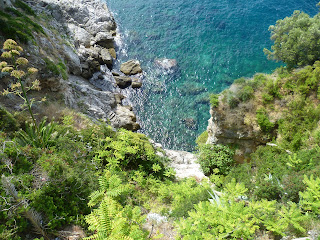
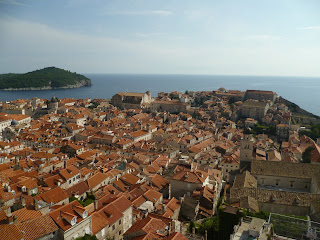
No comments:
Post a Comment